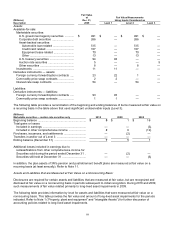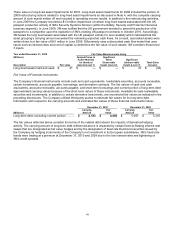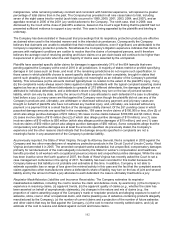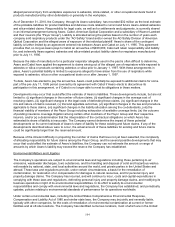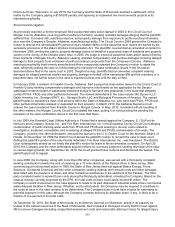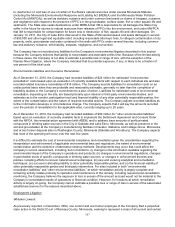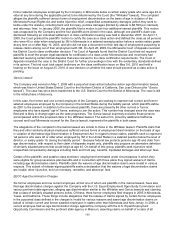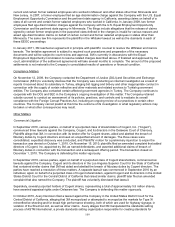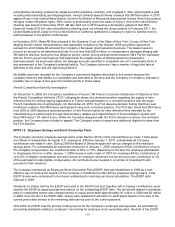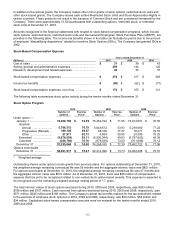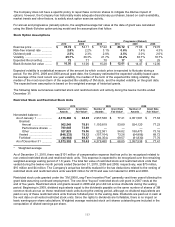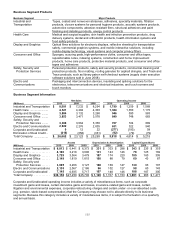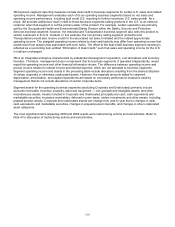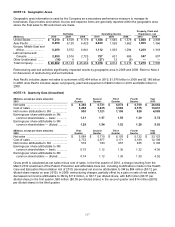3M 2010 Annual Report Download - page 114
Download and view the complete annual report
Please find page 114 of the 2010 3M annual report below. You can navigate through the pages in the report by either clicking on the pages listed below, or by using the keyword search tool below to find specific information within the annual report.108
former salaried employees employed by the Company in Minnesota below a certain salary grade who were age 46 or
older at any time during the applicable period to be determined by the Court (the “Whitaker” lawsuit). The complaint
alleges the plaintiffs suffered various forms of employment discrimination on the basis of age in violation of the
Minnesota Human Rights Act and seeks injunctive relief, unspecified compensatory damages (which they seek to
treble under the statute), including back and front pay, punitive damages (limited by statute to $8,500 per claimant)
and attorneys’ fees. In January 2006, the plaintiffs filed a motion to join four additional named plaintiffs. This motion
was unopposed by the Company and the four plaintiffs were joined in the case, although one plaintiff’s claim was
dismissed following an individual settlement. A class certification hearing was held in December 2007. On April 11,
2008, the Court granted the plaintiffs’ motion to certify the case as a class action and defined the class as all persons
who were 46 or older when employed by 3M in Minnesota in a salaried exempt position below a certain salary grade
at any time on or after May 10, 2003, and who did not sign a document on their last day of employment purporting to
release claims arising out of their employment with 3M. On April 28, 2009, the Minnesota Court of Appeals reversed
the District Court’s class certification decision. The Court of Appeals found that the District Court had not required
plaintiffs to meet the proper legal standards for certification of a class under Minnesota law and incorrectly had
deferred resolving certain factual disputes that were relevant to the class certification requirements. The Court of
Appeals remanded the case to the District Court for further proceedings in line with the evidentiary standards defined
in its opinion. The trial court took expert testimony on the class certification issue on May 5-6, 2010 and held a
hearing on the issue on August 25, 2010. A new decision on whether the case should proceed as a class action is
pending.
Garcia Lawsuit
The Company was served on May 7, 2009 with a purported class action/collective action age discrimination lawsuit,
which was filed in United States District Court for the Northern District of California, San Jose Division (the “Garcia
lawsuit”). The case has since been transferred to the U.S. District Court for the District of Minnesota. The case is still
in the initial phase of discovery.
In this case, five former and one current employee of the Company are seeking to represent all current and former
salaried employees employed by the Company in the United States during the liability period, which plaintiffs define
as 2001 to the present. In addition to the six named plaintiffs, there are presently 86 other current or former
employees who have signed “opt-in” forms, seeking to join the action. This number has changed since the case was
filed and is likely to change again as the case progresses. The Garcia lawsuit expressly excludes those persons
encompassed within the proposed class in the Whitaker lawsuit. The same firm, joined by additional California
counsel and local Minnesota counsel for the Garcia lawsuit, represents the plaintiffs in both cases.
The allegations of the complaint in the Garcia lawsuit are similar to those in the Whitaker lawsuit. Plaintiffs claim that
they and other similarly situated employees suffered various forms of employment discrimination on the basis of age
in violation of the federal Age Discrimination in Employment Act. In regard to these claims, plaintiffs seek to represent
“all persons who were 46 or older when employed by 3M in the United States in a salaried position below the level of
director, or salary grade 18, during the liability period.” Because federal law protects persons age 40 and older from
age discrimination, with respect to their claim of disparate impact only, plaintiffs also propose an alternative definition
of similarly situated persons that would begin at age 40. On behalf of this group, plaintiffs seek injunctive relief,
unspecified compensatory damages including back and front pay, benefits, liquidated damages and attorneys’ fees.
Certain of the plaintiffs’ and putative class members’ employment terminated under circumstances in which they
were eligible for group severance plan benefits and in connection with those plans they signed waivers of claims,
including age discrimination claims. Plaintiffs claim the waivers of age discrimination claims were invalid in various
respects. This subset of release-signing plaintiffs seeks a declaration that the waivers of age discrimination claims
are invalid, other injunctive, but non-monetary, remedies, and attorneys’ fees.
EEOC Age-Discrimination Charges
Six former employees and one current employee, all but one of whom are plaintiffs in the Garcia lawsuit, have also
filed age discrimination charges against the Company with the U.S. Equal Employment Opportunity Commission and
various pertinent state agencies, alleging age discrimination similar to the Whitaker and Garcia lawsuits and claiming
that a class of similarly situated persons exists. Of these, three former employees filed charges in 2005 in Minnesota,
Texas, and California. These filings include allegations that the release of claims signed by certain former employees
in the purported class defined in the charges is invalid for various reasons and assert age discrimination claims on
behalf of certain current and former salaried employees in states other than Minnesota and New Jersey. In 2006, a
current employee filed an age discrimination charge against the Company with the U.S. Equal Employment
Opportunity Commission and the pertinent state agency in Missouri, asserting claims on behalf of a class of all


